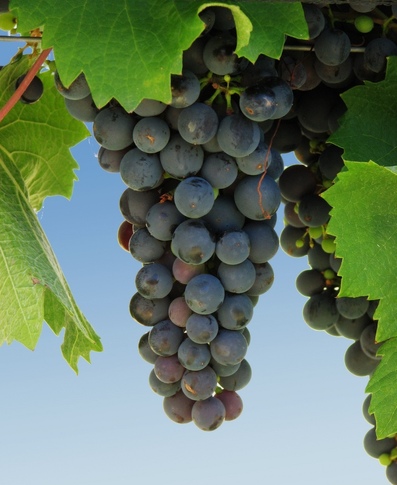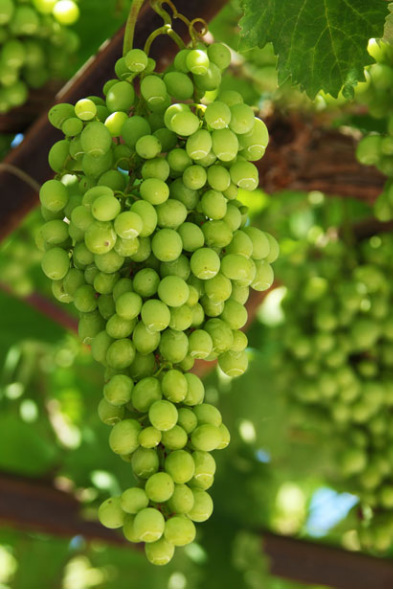Malbec

Malbec (pronounced: [mal.bɛk]) is a purple grape variety used in making red wine. The grapes tend to have an inky dark color and robust tannins, and are long known as one of the six grapes allowed in the blend of red Bordeaux wine.
The Malbec grape is a thin-skinned grape and needs more sun and heat than either Cabernet Sauvignon or Merlot to mature. It ripens mid-season and can bring very deep color, ample tannin, and a particular plum-like flavor component to add complexity to claret blends. Sometimes, especially in its traditional growing regions, it is not trellised and cultivated as bush vines (the goblet system).
As a varietal, Malbec creates a rather inky red (or violet), intense wine, so it is also commonly used in blends, such as with Merlot and Cabernet Sauvignon to create the red French Bordeaux claret blend. The grape is blended with Cabernet Franc and Gamay in some regions such as the Loire Valley. Other wine regions use the grape to produce Bordeaux-style blends. The varietal is sensitive to frost and has a proclivity to shatter or coulure.
The Malbec grape is a thin-skinned grape and needs more sun and heat than either Cabernet Sauvignon or Merlot to mature. It ripens mid-season and can bring very deep color, ample tannin, and a particular plum-like flavor component to add complexity to claret blends. Sometimes, especially in its traditional growing regions, it is not trellised and cultivated as bush vines (the goblet system).
As a varietal, Malbec creates a rather inky red (or violet), intense wine, so it is also commonly used in blends, such as with Merlot and Cabernet Sauvignon to create the red French Bordeaux claret blend. The grape is blended with Cabernet Franc and Gamay in some regions such as the Loire Valley. Other wine regions use the grape to produce Bordeaux-style blends. The varietal is sensitive to frost and has a proclivity to shatter or coulure.
Riesling

In the Pacific Northwest there is a
stark contrast in Riesling production. Riesling from this area
ranges from dry to sweet, and has a crisp lightness that bodes well
for easy drinking. Often there will be an easily detectable peach and
mineral complex.
In wine making, the delicate nature of the Riesling grape requires special handling during harvesting to avoid crushing or bruising the skin. Without this care, the broken skins could leak tannin into the juice, giving a markedly coarse taste and throwing off balance the Riesling’s range of flavours and aromas.
Riesling is a versatile wine for pairing with food, because of its balance of sugar and acidity. It can be paired with white fish or pork, and is one of the few wines that can stand up to the stronger flavors and spices of Thai and Chinese cuisine. A Riesling's typical aromas are of flowers, tropical fruits, and mineral stone (such as slate or quartz), although, with time, the wine acquires a petrol note as mentioned above.
Riesling is almost never fermented or aged in new oak (although large old oak barrels are often used to store and stabilize Riesling based wines in Germany and Alsace). This means that Riesling tends to be lighter weight and therefore suitable to a wider range of foods. The sharp acidity/sweetness in Rieslings can serve as a good balance to foods that have a high salt content.
In wine making, the delicate nature of the Riesling grape requires special handling during harvesting to avoid crushing or bruising the skin. Without this care, the broken skins could leak tannin into the juice, giving a markedly coarse taste and throwing off balance the Riesling’s range of flavours and aromas.
Riesling is a versatile wine for pairing with food, because of its balance of sugar and acidity. It can be paired with white fish or pork, and is one of the few wines that can stand up to the stronger flavors and spices of Thai and Chinese cuisine. A Riesling's typical aromas are of flowers, tropical fruits, and mineral stone (such as slate or quartz), although, with time, the wine acquires a petrol note as mentioned above.
Riesling is almost never fermented or aged in new oak (although large old oak barrels are often used to store and stabilize Riesling based wines in Germany and Alsace). This means that Riesling tends to be lighter weight and therefore suitable to a wider range of foods. The sharp acidity/sweetness in Rieslings can serve as a good balance to foods that have a high salt content.
